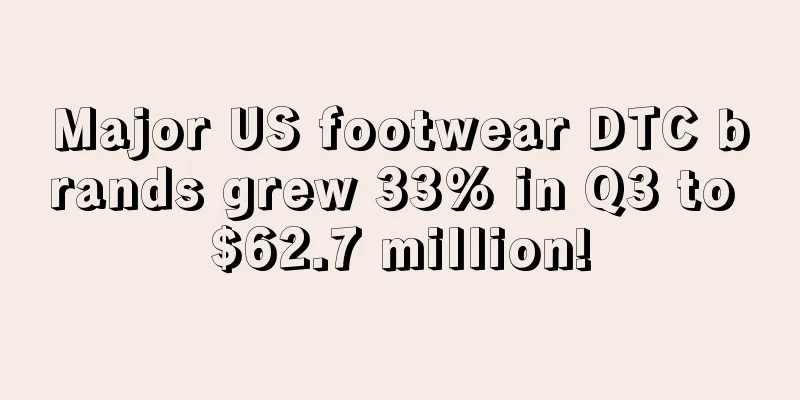It’s hard to get back 20 million! Amazon sellers say they were fooled by buyers

|
What I had been worrying about finally happened.
I still remember that at this time last year, the industry was full of news about how much money this aggregator had raised, how many brands that aggregator had acquired, or how new aggregators had rushed into the Chinese market as soon as they obtained financing ... and other positive news.
When this business model first emerged, many people raised questions about its feasibility, such as whether aggregators would have sufficient capabilities to operate brands after acquiring them, as well as data security issues during the acquisition process. Many people even predicted its prospects would be pessimistic.
Facts have proved that these concerns are not unfounded. Now that the industry is in a cold state, many problems have been exposed more quickly. Recently, two sellers on Yien.com reported this matter. One of them was stuck in a dilemma with the other party because he had not recovered tens of millions of yuan in payment. The other one was deceived because he did not receive the first payment in full after the brand and the collection account were all transferred to the other party.
On the other hand, as the industry cools down this year, the once bustling acquisition market is also cooling down rapidly. Not only is the speed at which aggregators obtain financing much slower, but the number of new deals in the market is also decreasing.
Guangzhou seller: I fell into a trap and it is difficult to recover more than 20 million yuan
"Due to the other party's unprofessional operation, my revenue has dropped significantly , and now it's difficult to get the balance back. " Li Hua (pseudonym) helplessly told Yien.com that he sold one of his brands to an Amazon brand aggregator in the United States, but now there are problems with the balance of more than 10 million yuan and more than 6 million yuan of inventory, and the other party did not respond to messages he sent to communicate.
Li Hua's brand has an annual gross profit of 5 million US dollars. The first payment for the sale of the brand has been received. According to the agreement, if the performance does not decline within one year after the account settlement and the transfer of payment methods are completed, that is, the annual gross profit is not less than 5 million US dollars, the remaining 10 million yuan can be obtained.
However, Li Hua fell into a trap here.
After the aggregator took over the operation of this brand, due to unstable operating personnel, the account could not operate normally. During this period, sales fell by half for three or four months, resulting in failure to meet the performance targets for the whole year.
"Their operations team was gathered from all over the world. Some were in Europe, some in the United States, and some in India. The operations manager changed two or three times during this period." Li Hua said that in order to increase traffic, these operations also added many words banned by Amazon to the listings, which led to the product being banned.
However, since the contract did not stipulate the quality of the aggregator's operations, Li Hua said that he had to bear the loss : "This situation was indeed not written into the contract, so I just accepted it."
However, Li Hua believes that the aggregator needs to give him the funds that are clearly stipulated in the agreement and have actually occurred, such as inventory. However, the collection of this money is not smooth. "When we delivered, the goods were still on the way, and the value of the goods and freight was more than 6 million yuan, but after the inventory expired, they stopped replying to the message."
Li Hua told Yien.com that the aggregator had another reason for not paying these amounts: fluctuations in purchasing prices.
"Last year, raw materials were rising in price. As the cost of raw materials changed, the factory's product prices naturally increased as well, but the increase was not large, only about four or five percentage points. But they used this as an excuse to say that we had not fulfilled our obligation to maintain supplier stability." Li Hua believes that if the price increase of products really has an impact on the other party's business, they can also negotiate a solution based on the degree of loss, rather than blaming each other.
What worries Li Hua even more is that if this trend spreads, aggregators may become more aggressive in the future, which will pose greater risks to sellers who want to sell their brands in the future. "After the seller transfers the account, it is possible that the first payment will not be received, because the acquisition process has many risks and pitfalls."
Regarding the risks in acquisitions, Li Hua mentioned that during the account transfer process, they found that the contracting entity and the account sampling entity were a new company, not the investor.
As we all know, Amazon stipulates that a company can only hold one Amazon account. In order to acquire more accounts, these aggregators will register many new companies. One company holds one purchased account. Therefore, the company that signs a contract with the seller is usually not the capital itself, but its subsidiary. And the risks are hidden in these companies.
"The registered capital of these companies is very small, some may only be 10,000 US dollars. If you transfer your account to it and the new company does not pay you, you sue it, the maximum amount of compensation is only 10,000 US dollars, and the lawsuit will be filed abroad." Li Hua said. Li Hua was not the only one who fell into the trap in transactions with aggregators. Zhou Wei (pseudonym), a seller from Foshan, also suffered a lot.
Foshan seller: I was cheated, nearly 17 million yuan was stuck
"Now they have been refusing to pay our $2.5 million trademark fee, claiming that the Spanish VAT has not yet been paid." Zhou Wei told Yien.com that their brand has accounts in Europe, the United States and Japan. Currently, the brands have been transferred to the acquirer. In terms of the main body, Japan and North America have already transferred the main body, but the other party in Europe has not transferred it on the grounds that Spain does not have VAT.
Zhou Wei's brand was also sold to an American aggregator for $6 million, including $5 million in the first installment and $1 million in the final installment. The first installment of $5 million was divided into an account payment ($2.5 million) and a trademark payment ($2.5 million). The contract stipulates that $500,000 of the account payment will be paid one and a half years after the contract is signed, and the remaining $2 million and the $2.5 million for the trademark will be paid after the account is fully delivered.
Now the delivery process is stuck at the Spanish VAT. " They claim that if there is no transfer entity in Europe, the transfer is not considered successful, so they will not pay. In fact, our business in Europe only involves the UK, France, Germany and Italy, and we have no business in Spain. " Zhou Wei said helplessly: "Now the other party says that although there is no business, Spain has no VAT, so they cannot carry out the pan-European plan."
Now Zhou Wei regrets mentioning the VAT clause in the agreement . "Because the VAT application process was very slow last year, we verbally communicated at the time that we could not wait until all the VATs were paid before we completed the transaction. They agreed at the time, but I didn't expect that in the final agreement, they changed the clause to require the seller to pay the VAT fee for the buyer before the buyer's VAT was paid."
There is a risk here, because the seller does not know whether the acquirer has applied for Spanish VAT. "We asked them to provide us with the materials for applying for Spanish VAT to prove that they did not delay maliciously, but they were unwilling to do so."
Now it has been more than five months since the two parties signed the agreement, but Zhou Wei has only received 2.66 million US dollars so far, of which 2 million US dollars was released from the escrow company after he went through multiple rounds of communication.
Not only that, when the $2.5 million trademark payment had not yet been settled, Zhou Wei was notified that a sum of $125,000 would be deducted.
The acquirer informed Zhou Wei that because the sales of several minor variants among the variants far exceeded expectations, resulting in out-of-stock, they would deduct US$125,000 as compensation.
Zhou Wei protested this: "The sales volume of the entire link increased during the shortage period. We did provide sales forecasts for December last November and January and February this year, but we never promised a certain number of orders. Moreover, sales forecasts cannot be fulfilled as sales commitments, and this was not written into the contract."
Not only that, according to Zhou Wei's investigation of past data, the main reason for out-of-stock is at the market level, because a product suddenly became popular and sales increased 2 to 3 times compared to before, and according to sales estimates, they had enough stock, but because of the increase in sales, it was too late to place new orders, which led to out-of-stock.
"In early June, we received an email from their lawyer, which stated that as long as we agreed to deduct the money for out-of-stock, the remaining money would be given to us before July 1. If we didn't agree, we wouldn't get paid . " In Zhou Wei's opinion, the acquirer mainly wanted to reduce the interest they paid by delaying payment and deduct money from it. VAT and out-of-stock were just their excuses. "This year, we also applied for Spanish VAT, which usually takes about a month, and the longest is 40 days. But so far, it has been five months, and their application has not been approved yet."
Selling a brand is risky. If you are not careful, you may lose both your money and your brand.
After reading the experiences of the two sellers mentioned above, I believe many people feel that: "You must take the agreement seriously with all your heart." On the one hand, you must remember that only what is written in black and white has legal effect, and verbal promises cannot bring any guarantees. On the other hand, the terms of the agreement must be detailed enough, and possible risks should be explained in the agreement as much as possible.
Another thing worth noting is that because it is a foreign language contract, we need to be careful about the acquirer playing word games. Zhou Wei has a deep understanding of this. Because of his negligence in this regard, he directly lost more than 140,000 US dollars. "In theory, the reserved funds in the account belong to the seller. We have repeatedly confirmed this with the acquirer, but in the end they played a trick on us in the agreement." Zhou Wei said angrily: "The English name for account balance is 'Account balance', but in the agreement they used a completely incomprehensible word, which led us to ignore this part, which precisely stipulates that the account balance belongs to the acquirer."
In general, there are many risks in the entire delivery process. In addition, the specific circumstances of each case are different, so sellers need to grasp the relevant contracts more firmly. However, as a person who has experienced it, Li Hua also pointed out the problems with the current acquisition agreements signed between aggregators and sellers. "It is not like a complete merger and acquisition, which clearly stipulates what will happen if you fail to do something and what will happen if you do something. It is actually a bunch of vague descriptions."
Therefore, in order to avoid risks, Li Hua and Zhou Wei, who have experienced pitfalls, both believe that it is very important to confirm whether the other party is a good capital party before cooperation, such as confirming the other party's financial strength, whether it has raised money, and whether there are some bad records. “Some aggregators may not have money on hand. They will raise funds after signing the acquisition contract with the seller. In this way, it is very difficult for the seller to get the money, and it is very likely that both the money and the account will be lost.” Li Hua said that such freeloading is not uncommon. “Previously, an acquirer claimed to have completed an acquisition of a case with an annual gross profit of US$15 million, but in fact they only gave 10% of the money.”
Zhou Wei also has a lot to say about aggregators with bad records: "If other sellers want to sell their brands in the future, the first thing they need to do is to choose an acquirer with a good reputation. We suffered a loss because we had heard that the acquirer we cooperated with had some bad records. But at that time, we thought that we were bound by the contract and that we just needed to be careful in the contract. However, we didn't expect that they had many more tricks than we imagined."
An industry insider close to multiple acquirers also agrees with Li Hua and Zhou Wei's views, and at the same time, he also gave three suggestions: 1. Strive for the highest possible down payment and do your utmost to reduce the risk of not being able to recover the balance. After all, the time and cost of collecting payments across borders are relatively high. 2. Carefully check your obligations and commitments. Do not be too relaxed just because it is a standard contract, so as to avoid the acquirer arbitrarily using relevant clauses to argue; 3. Once a dispute occurs, you must dare to make legal claims and entrust a professional lawyer who is familiar with local laws and regulations to resolve it.
However, even though sellers face many unknown risks in the transaction process with aggregators, it is undeniable that the business model of aggregators acquiring Amazon brands has its market. Although he has encountered some pitfalls in this process, Li Hua also agrees with this point. He said that under the premise that there is no possibility of an IPO for the company, selling the brand is a better option for sellers who want to exit. In addition, for sellers who want to build a brand, they can sell some brands that are more miscellaneous and the funds obtained can also be used to support the development of the main brand. However, due to the influence of various factors, Amazon's brand acquisition market has cooled down significantly, and the speed of aggregator financing and brand acquisition has slowed down.
Aggregator financing slows down, Amazon's brand acquisition market cools down
Marketplace data shows that Amazon aggregators raised $5.1 billion in the first half of 2021, compared to just $2.2 billion in the first half of this year. The race to launch and fund new aggregators has stalled. In the first half of 2022, only 12 new aggregators announced funding, attracting a combined $1 billion. The rest of the $2.2 billion raised went to companies raising additional rounds. In comparison, 22 new aggregators announced funding in the first half of 2021 and 17 in the second half.
Not only that, Yien.com observed that there are fewer cases of successful acquisitions by aggregators reported in the market this year.
Last year, low interest rates, historic growth in e-commerce, low multiples, and the success of Thrasio and the first batch of aggregators drove most of the investment, and the Amazon brand acquisition market was hot. However, this wave of enthusiasm has quickly cooled this year. At this time, some voices said that investors are no longer so confident in Amazon account acquisitions, and aggregators may not be able to raise money in the future. Existing aggregators that have already raised funds are also at a loss as to what to do next.
What is the real reason why Amazon's brand acquisition market has cooled? Can this business model continue to develop? The person in charge of an aggregator answered the question from an investment perspective:
1. The increase in traffic and costs will result in poor indicators for sellers in 2021 and the first quarter of 2022, which will reduce acquisition expectations for acquirers.
2. The acquirer market, especially Amazon Aggregator (Amazon brand aggregator) and other acquirers, also have their own business growth cycle. After acquiring a brand, there is a process of accumulation and digestion.
3. There are some uncertainties in the Amazon market and the world economy. Financial markets are very afraid of uncertainty. When uncertainty exists, they tend to ensure survival first. If the target is not very good, they will choose to put it aside for the time being.
In addition, many industry professionals believe that the failure of Thrasio, a leading aggregator, to successfully go public in the United States has also had a certain impact on the entire financing market. After all, whether it is the amount of financing or the number of Amazon brands acquired, it has always been unique among the entire aggregator group. At the same time, it is also the fastest target to achieve profitability in the entire PE field. Therefore, it has a weather vane and guiding significance for capital investment in this field.
In addition, Thrasio's IPO failure also sends a message to other aggregators: "This is not a business that makes quick money. You still need to take steady steps and improve your profitability."
“Once this information reaches the capital market or aggregator sector, they will be more conservative in investment and acquisitions and not as aggressive as before. For example, aggregators used to consider more about how many targets to acquire in a year, but now they want to ensure that the targets they acquire can achieve their expected internal return targets.” said the head of the aggregator.
In fact, the shrinking of aggregators can also give us a glimpse into the Amazon brand acquisition market. Not long ago, Thrasio, a unicorn in the aggregator business circle that has been growing at a very fast pace, was suddenly exposed to lay off some employees.
Fortunately, although the financing speed of aggregators has slowed down a lot, capital has not given up investing in this field. Just last month, there were three financings in the aggregator field, among which an aggregator from Singapore received US$45 million.
But one thing that may need to be noted is that as the Amazon brand acquisition market cools down, brand valuations may not meet sellers’ psychological expectations.
In general, from the huge amount of funds raised by a large number of aggregators to the successful sale of their own brands by many sellers, it has been proven that the business model of aggregators acquiring Amazon brands is not problematic, but in the process of the transaction, sellers should pay attention to the avoidance of related risks. The cooling of the market will suppress the overly aggressive expansion of aggregators, which will help prevent them from going bankrupt due to lack of attention to management and precipitation. This is not a good thing for aggregators or sellers. Sellers who are ready to sell their brands can also conduct more research on aggregators and market conditions during this period. Amazon Brand Acquirer Amazon Aggregator |
<<: With over 14,000 five-star reviews, another hit product from Amazon is released!
>>: Fashion trends are changing, and 25 categories of products are out of fashion
Recommend
107 incident reports, property damage of approximately $17 million, another product failure...
With the rapid development of society and the imp...
What is Mantaro? Mantaro Review, Features
Mantaro is a Canadian company that specializes in ...
What is Wantable? Wantable Review, Features
Wantable was founded in April 2012. It is a perso...
Amazon Air flights increase 34%, will it threaten UPS and FedEx?
Amazon Air rapidly expanded its network and fleet...
Domestic children's trucks recalled due to lead poisoning risk
Toys are the first choice for many consumers to p...
British EO Charging plans to be listed in the US to help deliveries
EO Charging recently announced a merger with Firs...
What is bloomingltd? bloomingltd Review, Features
bloomingltd is a hong kong based manufacturing and...
What is hip ecommerce? hip ecommerce Review, Features
hip ecommerce is built specifically for collectibl...
Another problem! Nearly 25,000 Amazon coffee machines recalled
Safety is a commonplace topic. Although we always...
Black Friday Cyber Monday will start on November 18th. Will sellers be able to achieve a surge in orders?
Prime Day has just ended, and Amazon’s Black Frid...
What is DataHawk? DataHawk Review, Features
DataHawk is a software analytics platform that hel...
Tik Tok's Ramadan activities: Middle Eastern sellers should learn from them
On Tik Tok, there is a hashtag #RamadanVibes that...
2024 cross-border e-commerce starts off hot, Chinese sellers seize new year business opportunities on the SHEIN platform
The cross-border e-commerce industry has received...
Don't underestimate! Easter gift card sales will increase more than 3 times
According to foreign media reports, according to ...
NRF: Valentine's Day spending in North America will change due to the epidemic
The trade group surveyed 7,882 adult consumers fr...









